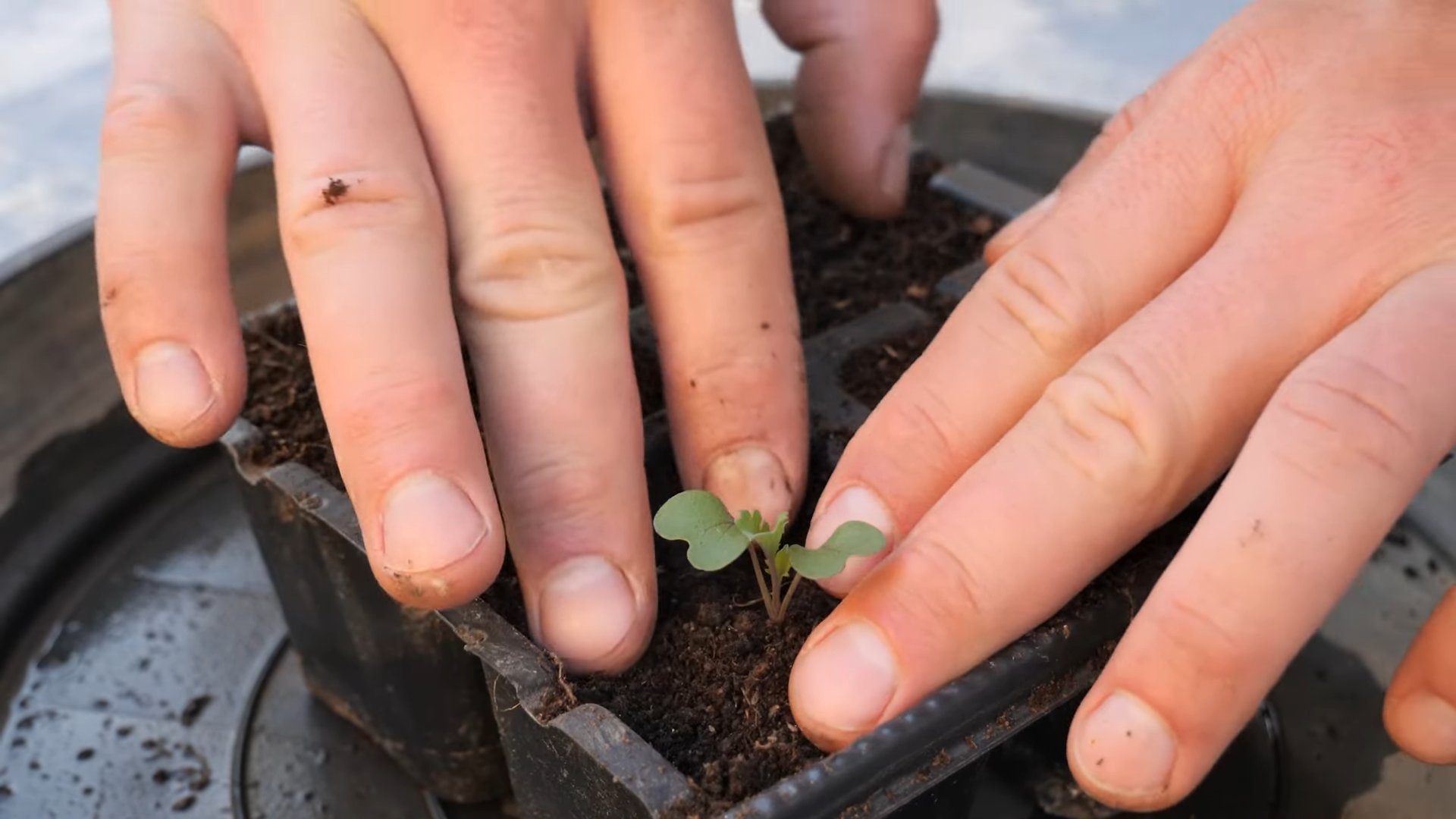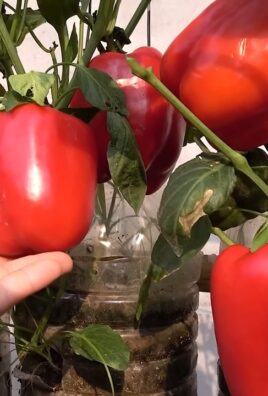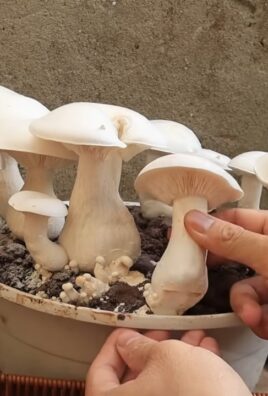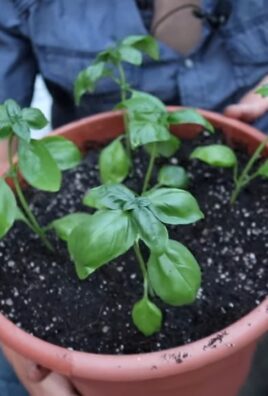Grow Kale at Home, even if you think you don’t have a green thumb! Are you tired of paying exorbitant prices for organic kale at the grocery store? Do you dream of whipping up delicious, nutrient-packed smoothies with kale fresh from your own backyard? Well, you’re in the right place! For centuries, kale has been a staple in diets around the world, from the hearty stews of Scotland to the vibrant salads of the Mediterranean. It’s a powerhouse of vitamins and minerals, and thankfully, it’s surprisingly easy to cultivate yourself.
I’m going to share some simple, yet effective DIY tricks and hacks that will have you harvesting your own bountiful kale crop in no time. Whether you have a sprawling garden or just a sunny windowsill, these tips will help you grow kale at home successfully. Imagine the satisfaction of knowing exactly where your food comes from, reducing your carbon footprint, and saving money – all while enjoying the delicious, healthy benefits of homegrown kale. Let’s get started!

Grow Your Own Delicious Kale: A Beginner’s Guide
Okay, kale lovers (and soon-to-be kale lovers!), let’s dive into the wonderful world of growing your own kale. Trust me, it’s easier than you think, and the taste of freshly harvested kale from your own garden is simply unbeatable. Plus, you’ll save money and have a constant supply of this nutritional powerhouse. I’m going to walk you through everything you need to know, from choosing the right variety to harvesting your bounty.
Choosing Your Kale Variety
First things first, let’s talk kale varieties. There are so many to choose from, each with its own unique flavor and texture. Here are a few popular options:
- Curly Kale (Scotch Kale): This is probably the kale you’re most familiar with. It has tightly curled leaves and a slightly bitter taste, which mellows out when cooked.
- Lacinato Kale (Dinosaur Kale or Tuscan Kale): This variety has long, dark green, almost black leaves with a slightly bumpy texture. It’s known for its mild, slightly sweet flavor and holds up well in cooking.
- Red Russian Kale: This kale has flat, fringed leaves with purple stems. It’s sweeter and more tender than curly kale, making it great for salads.
- Redbor Kale: This is a beautiful ornamental kale with deeply ruffled, purple leaves. It’s also edible and has a slightly milder flavor than curly kale.
I personally love Lacinato kale for its versatility, but feel free to experiment and find your favorite!
Getting Started: Seeds vs. Seedlings
You have two main options for starting your kale: from seeds or from seedlings (also called transplants).
- Starting from Seeds: This is the more economical option, and it gives you more control over the entire growing process. You can start seeds indoors 6-8 weeks before the last expected frost, or direct sow them outdoors a few weeks before the last frost.
- Starting from Seedlings: This is a faster and easier option, especially if you’re a beginner. You can purchase seedlings from your local garden center. Just make sure to choose healthy-looking plants with no signs of pests or diseases.
I usually start my kale from seeds indoors to get a head start on the growing season.
Preparing Your Growing Space
Kale thrives in well-drained soil that is rich in organic matter. Here’s how to prepare your growing space:
- Choose a Sunny Location: Kale needs at least 6 hours of sunlight per day.
- Prepare the Soil: Dig in plenty of compost or well-rotted manure to improve soil fertility and drainage. Kale prefers a slightly acidic to neutral soil pH (6.0-7.0). You can test your soil pH with a soil testing kit.
- Consider Raised Beds or Containers: If your soil is poor or poorly drained, consider growing kale in raised beds or containers. This will give you more control over the growing environment.
I’ve found that adding a good amount of compost makes a huge difference in the health and productivity of my kale plants.
Step-by-Step Instructions: Growing Kale from Seeds
Okay, let’s get our hands dirty! Here’s how to grow kale from seeds:
Starting Seeds Indoors
1. Gather Your Supplies: You’ll need seed starting trays or pots, seed starting mix, kale seeds, a spray bottle, and a grow light (optional).
2. Fill the Trays/Pots: Fill your seed starting trays or pots with seed starting mix.
3. Sow the Seeds: Sow the kale seeds about 1/4 inch deep in the soil. I usually plant 2-3 seeds per cell to increase my chances of germination.
4. Water Gently: Water the soil gently with a spray bottle to avoid disturbing the seeds.
5. Provide Light and Warmth: Place the trays/pots in a warm location (around 70-75°F) and provide plenty of light. If you don’t have a sunny window, use a grow light.
6. Keep the Soil Moist: Keep the soil consistently moist, but not soggy.
7. Thin the Seedlings: Once the seedlings have their first true leaves (the second set of leaves), thin them to one plant per cell. Choose the strongest seedling and snip off the others at the soil line.
8. Harden Off the Seedlings: Before transplanting the seedlings outdoors, you need to harden them off. This means gradually exposing them to outdoor conditions over a period of 7-10 days. Start by placing them in a sheltered location for a few hours each day, gradually increasing the amount of time they spend outdoors.
Direct Sowing Seeds Outdoors
1. Prepare the Soil: As mentioned earlier, prepare the soil by digging in plenty of compost or well-rotted manure.
2. Sow the Seeds: Sow the kale seeds about 1/2 inch deep in rows, spacing the rows about 18-24 inches apart.
3. Water Gently: Water the soil gently after sowing.
4. Keep the Soil Moist: Keep the soil consistently moist until the seeds germinate.
5. Thin the Seedlings: Once the seedlings have their first true leaves, thin them to about 12-18 inches apart.
Step-by-Step Instructions: Growing Kale from Seedlings
If you’re starting with seedlings, the process is even simpler:
1. Prepare the Soil: Again, make sure your soil is well-drained and rich in organic matter.
2. Dig Holes: Dig holes that are slightly larger than the root balls of the seedlings, spacing them about 12-18 inches apart.
3. Remove Seedlings from Pots: Gently remove the seedlings from their pots, being careful not to damage the roots.
4. Plant the Seedlings: Place the seedlings in the holes and backfill with soil. Make sure the top of the root ball is level with the soil surface.
5. Water Thoroughly: Water the seedlings thoroughly after planting.
Caring for Your Kale Plants
Once your kale plants are established, here’s how to keep them healthy and productive:
- Watering: Kale needs consistent moisture, especially during hot, dry weather. Water deeply whenever the top inch of soil feels dry.
- Fertilizing: Fertilize your kale plants every few weeks with a balanced organic fertilizer. I like to use fish emulsion or compost tea.
- Weeding: Keep the area around your kale plants free of weeds. Weeds compete with kale for nutrients and water.
- Pest Control: Kale can be susceptible to pests such as aphids, cabbage worms, and flea beetles. Inspect your plants regularly and take action if you see any signs of pests. You can use organic pest control methods such as insecticidal soap or neem oil.
- Mulching: Mulch around your kale plants with straw, wood chips, or shredded leaves to help retain moisture, suppress weeds, and regulate soil temperature.
I’ve found that consistent watering and regular fertilizing are key to getting a good harvest of kale.
Dealing with Common Kale Pests and Diseases
Even with the best care, your kale plants might encounter some problems. Here’s how to deal with some common issues:
- Aphids: These tiny insects suck sap from the leaves, causing them to curl and distort. You can control aphids by spraying them with insecticidal soap or neem oil.
- Cabbage Worms: These green caterpillars chew holes in the leaves. You can control cabbage worms by handpicking them off the plants or by using Bacillus thuringiensis (Bt), a natural insecticide.
- Flea Beetles: These tiny beetles jump when disturbed and chew small holes in the leaves. You can control flea beetles by covering your plants with row covers or by using insecticidal soap or neem oil.
- Downy Mildew: This fungal disease causes yellow spots on the upper surface of the leaves and a white, downy growth on the underside. You can prevent downy mildew by providing good air circulation and avoiding overhead watering. If you see signs of downy mildew, remove the affected leaves and spray the plants with a copper fungicide.
Regularly inspecting your plants and taking action quickly is the best way to prevent pest and disease problems.
Harvesting Your Kale
Now for the best part: harvesting your kale!
- When to Harvest: You can start harvesting kale leaves when they are about 6-8 inches long.
- How to Harvest: Harvest the outer leaves first, leaving the inner leaves to continue growing. You can harvest kale leaves continuously throughout the growing season.
- How to Store: Store kale leaves in the refrigerator in a

Conclusion
So, there you have it! Growing kale at home is not only achievable, but it’s also a rewarding experience that brings fresh, nutritious greens right to your kitchen. We’ve walked through the simple steps, from selecting the right seeds to harvesting your bountiful crop. But why is this DIY trick a must-try?
Firstly, consider the unparalleled freshness. Store-bought kale, even when organic, can’t compare to the vibrant flavor and crisp texture of kale harvested moments before you eat it. You control the entire process, ensuring no harmful pesticides or chemicals come near your leafy greens. This is especially important for those prioritizing a clean and healthy diet.
Secondly, growing your own kale is incredibly cost-effective. A single packet of kale seeds can yield a continuous supply of greens for months, significantly reducing your grocery bill. Think of all the delicious kale salads, smoothies, and stir-fries you can enjoy without breaking the bank!
Thirdly, it’s an incredibly satisfying hobby. There’s something deeply fulfilling about nurturing a plant from seed to harvest. It connects you to nature, provides a sense of accomplishment, and offers a welcome break from the digital world. Plus, it’s a fantastic way to get kids involved in gardening and teach them about where their food comes from.
But the benefits don’t stop there. Growing kale at home allows you to experiment with different varieties. Why stick to the standard curly kale when you can try Lacinato (dinosaur) kale, Red Russian kale, or even ornamental kale for a splash of color in your garden? Each variety offers a unique flavor profile and texture, adding variety to your culinary creations.
Feeling adventurous? Consider companion planting. Kale thrives alongside herbs like rosemary, sage, and thyme, which can help deter pests and enhance the flavor of your kale. You can also plant it near vegetables like beets, carrots, and onions for a mutually beneficial relationship.
Don’t have a large garden? No problem! Kale is surprisingly adaptable and can be grown in containers on a balcony, patio, or even a sunny windowsill. Just make sure to choose a pot that’s at least 12 inches deep and wide to accommodate the plant’s root system.
We encourage you to take the plunge and try growing kale at home. It’s easier than you think, and the rewards are well worth the effort. From the moment you sow the seeds to the moment you harvest your first leaves, you’ll be amazed by the resilience and productivity of this incredible plant.
And now, we want to hear from you! Share your experiences, tips, and tricks for growing kale at home in the comments below. What varieties have you tried? What challenges have you faced? What successes have you celebrated? Let’s create a community of kale-growing enthusiasts and learn from each other.
Remember, even if you don’t have a green thumb, don’t be discouraged. Gardening is a learning process, and every mistake is an opportunity to grow (pun intended!). So, grab a packet of seeds, get your hands dirty, and start growing your own delicious and nutritious kale today! You’ll be amazed at how easy it is to enjoy fresh, homegrown kale right from your own backyard.
Frequently Asked Questions (FAQ)
What is the best time of year to plant kale?
Kale is a cool-season crop, meaning it thrives in cooler temperatures. The best time to plant kale depends on your climate. In areas with mild winters, you can plant kale in the fall for a winter harvest. In colder climates, plant kale in early spring, a few weeks before the last expected frost. You can also start seeds indoors 6-8 weeks before the last frost and transplant them outdoors once the weather warms up. For a continuous harvest, consider succession planting, sowing new seeds every few weeks.
How much sunlight does kale need?
Kale needs at least 6 hours of sunlight per day to thrive. Choose a location in your garden that receives full sun for the best results. If you’re growing kale in containers, make sure to place them in a sunny spot. If you live in a particularly hot climate, some afternoon shade can be beneficial to prevent the leaves from scorching.
What kind of soil is best for growing kale?
Kale prefers well-drained soil that is rich in organic matter. Amend your soil with compost or aged manure before planting to improve its fertility and drainage. Kale also prefers a slightly acidic to neutral soil pH, between 6.0 and 7.0. You can test your soil pH with a soil testing kit and amend it accordingly.
How often should I water kale?
Kale needs consistent moisture to thrive. Water your kale plants regularly, especially during dry periods. Aim to keep the soil consistently moist but not waterlogged. Overwatering can lead to root rot. A good rule of thumb is to water deeply when the top inch of soil feels dry to the touch. Mulching around your kale plants can help retain moisture and suppress weeds.
What are some common pests and diseases that affect kale?
Kale can be susceptible to several pests and diseases, including aphids, cabbage worms, flea beetles, and downy mildew. Regularly inspect your plants for signs of infestation or disease. You can control aphids with insecticidal soap or neem oil. Cabbage worms can be handpicked or controlled with Bacillus thuringiensis (Bt). Flea beetles can be deterred with row covers. Downy mildew can be prevented by ensuring good air circulation and avoiding overhead watering.
How do I harvest kale?
You can start harvesting kale leaves once they reach a usable size, typically about 4-6 inches long. Harvest the outer leaves first, leaving the inner leaves to continue growing. This cut-and-come-again method allows you to harvest kale continuously for several weeks or even months. Simply snap or cut the leaves off near the base of the plant. Avoid harvesting more than one-third of the plant at a time to ensure it continues to produce new leaves.
Can I grow kale indoors?
Yes, you can grow kale indoors, but it requires sufficient light. Place your kale plants near a sunny window that receives at least 6 hours of direct sunlight per day. If you don’t have enough natural light, you can supplement with grow lights. Use a well-draining potting mix and water regularly. Indoor kale plants may not grow as large as outdoor plants, but you can still harvest a decent amount of leaves.
How do I store harvested kale?
To store harvested kale, wash the leaves thoroughly and dry them completely. Wrap the leaves in a paper towel and place them in a plastic bag in the refrigerator. Kale can be stored in the refrigerator for up to a week. You can also freeze kale for longer storage. Blanch the leaves in boiling water for 2-3 minutes, then plunge them into ice water. Drain the leaves and squeeze out any excess water. Place the blanched kale in freezer bags and store them in the freezer for up to 6 months.
What are some ways to use kale in cooking?
Kale is a versatile vegetable that can be used in a variety of dishes. It can be eaten raw in salads, sautéed, steamed, baked, or added to soups, stews, and smoothies. Kale chips are a popular and healthy snack. You can also use kale in stir-fries, frittatas, and pasta dishes. Experiment with different recipes and find your favorite ways to enjoy this nutritious green.
Is kale a good source of nutrients?
Yes, kale is an excellent source of nutrients. It is packed with vitamins A, C, and K, as well as calcium, iron, and antioxidants. Kale is also a good source of fiber, which is important for digestive health. Adding kale to your diet can help boost your immune system, improve bone health, and protect against chronic diseases.





Leave a Comment